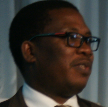Gauteng’s matric pass rate could have been better – Lesufi
Johannesburg – Gauteng’s 85.1% matric pass rate was commendable, but could have been better, education MEC Panyaza Lesufi said on Thursday.
It was slightly better than the 84.2% the class of 2015 managed, he said at an awards ceremony for the province’s best matrics in Daveyton, on the East Rand.
Excluding the so-called progressed pupils, the pass rate was 87%.
“I remain convinced that we can do much better provincially,” Lesufi said.
Gauteng was third nationally, behind the Free State, which achieved a 93.2% pass rate, and the Western Cape, with 87.7%.
Despite this, it was important to recognise the gains and improvements that the province had made, he said.
'A good achievement'
“Given the comments by Umalusi and the very tough papers in some of the subjects, 85.1% is a good achievement.”
Gauteng produced the highest number of pupils with bachelor’s passes in the country.
Of the 103 829 matriculants who wrote the exam in Gauteng, 36% qualified for admission to study towards a bachelor’s degree, while 35.8% got diploma passes.
Both numbers were up from last year.
Lesufi applauded the matriculants at Pretoria High School for Girls and said he wished more schools had their resilience. Of the 260 pupils who wrote matric at the school, 251 got bachelor’s passes, despite racial tensions and protests about how black girls could wear their hair.
Investing in township schools had paid off as the number of those getting 100% pass rates had increased. Over 13% of these ‘100% pass schools’ were no-fee schools, he said.
Raymond Mhlaba Secondary School was one such school. More than half of its matrics got bachelor’s passes and over a third got diploma passes.
A total of 93% of all schools in Gauteng got above the national benchmark of 60%. For the first time, no schools got pass rates below 20%.
Lesufi would hold meetings with the management of all public schools that got below 50% and hold them to account for their poor performance.
Meanwhile, the gap in pass rates between schools in poor communities and those in wealthy middle-class areas was closing, he said.
Although both types of schools achieved better results, township schools made bigger gains.
Investment in no-fee schools
No-fee schools improved their pass rates from 77.9% in 2015 to 79% in 2016. Fee-paying schools dropped slightly from 91.2% in 2015 to 91% last year.
“It is now, not uncommon, that a school like Sekano-Ntoane Secondary School in Soweto, with a pass rate of 98.7% performs, comparatively, as well as an established school like Jeppe Boys High School that achieved 98.4%,” he said.
Part of the reason the no-fee schools, which were mainly in townships, had performed so well was due to the technology that the department had invested in them, and supplementary learning programmes.
Gauteng had the largest number of progressed pupils across the country, 11 596. A total of 61% of them passed matric. Of that group, nearly 9% received bachelor’s passes and over 30% diploma passes.
Pushing pupils who had failed a grade repeatedly to the next one was done in countries including Finland, Sweden, Denmark, Japan, Korea, and the United Kingdom.
“These countries are pro-automatic progression instead of repetition. This approach has been found to be efficient. These are learners who would have had to repeat Grade 11 in 2016,” Lesufi said.
The three schools with the most distinctions were Afrikaanse Hoër Meisieskool (730), Hoërskool Menlopark (721) and Hoërskool Garsfontein (710).

